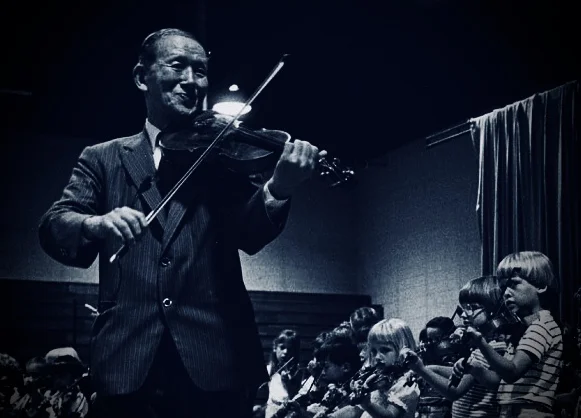The Suzuki Approach
Japanese violinist Shin’ichi Suzuki realized the implications of the fact that children the world over learn to speak their native language with ease. He began to apply the basic principles of language acquisition to the learning of music, and called his method the Mother-Tongue Approach. The ideas of parent responsibility, loving encouragement, constant repetition, etc., are some of the special features of the Suzuki approach.
The early years are crucial for developing mental processes and muscle coordination, so listening to high quality music is an essential practice of the musical child. Formal training begins between the age of 4 to 6 years, though older students may begin study in the Suzuki Approach on a case-by-case basis. Children learn words after hearing them spoken hundreds of times by others. Listening to music every day is important, and Suzuki families make a habit of listening to the repertoire recordings that accompany each Suzuki Book.
Repetition of skills is an important part of learning to play any instrument. Contrary to many traditional approaches in which pieces are studied and discarded, Suzuki children add skills to their musical vocabulary and pieces to their repertoire. By playing familiar songs every day, children gradually make music in new and sophisticated ways.
Suzuki children gain fluency in their musical language long before they are musically literate. Just as a child learns the letters of the alphabet and phonic sounds before they start spelling words and composing sentences, Suzuki students develop aural flexibility at an early age. Note names are incorporated into every lesson, and students are assigned activities to build pitch and rhythmic recognition apart from their instrument. Children do not practice exercises to learn to talk, but use language for its natural purpose of communication and self-expression. Pieces in the Suzuki repertoire are designed to present technical problems to be learned in the context of the music rather than through dry technical exercises.
Parent Involvement
The child’s effort to learn an instrument should be met with sincere praise and encouragement. Each child learns at his/her own rate, building on small steps so that each one can be mastered. Children are also encouraged to support each other’s efforts, fostering an attitude of generosity and cooperation. In addition to private lessons, children participate in regular group or partner lessons at which they learn from and are motivated by each other.
As when a child learns to talk, parents are involved in the musical learning of their child. Parents receive “mini-lessons” within their child’s lesson time. This instruction is intended to help the parent serve as “home teacher” throughout the week. Especially during the early stages of their child’s skill development, parents participate in group classes with other adults. Guided by the Suzuki instructor, these classes help parents understand the Suzuki Approach and troubleshoot the early struggles of home practice.

